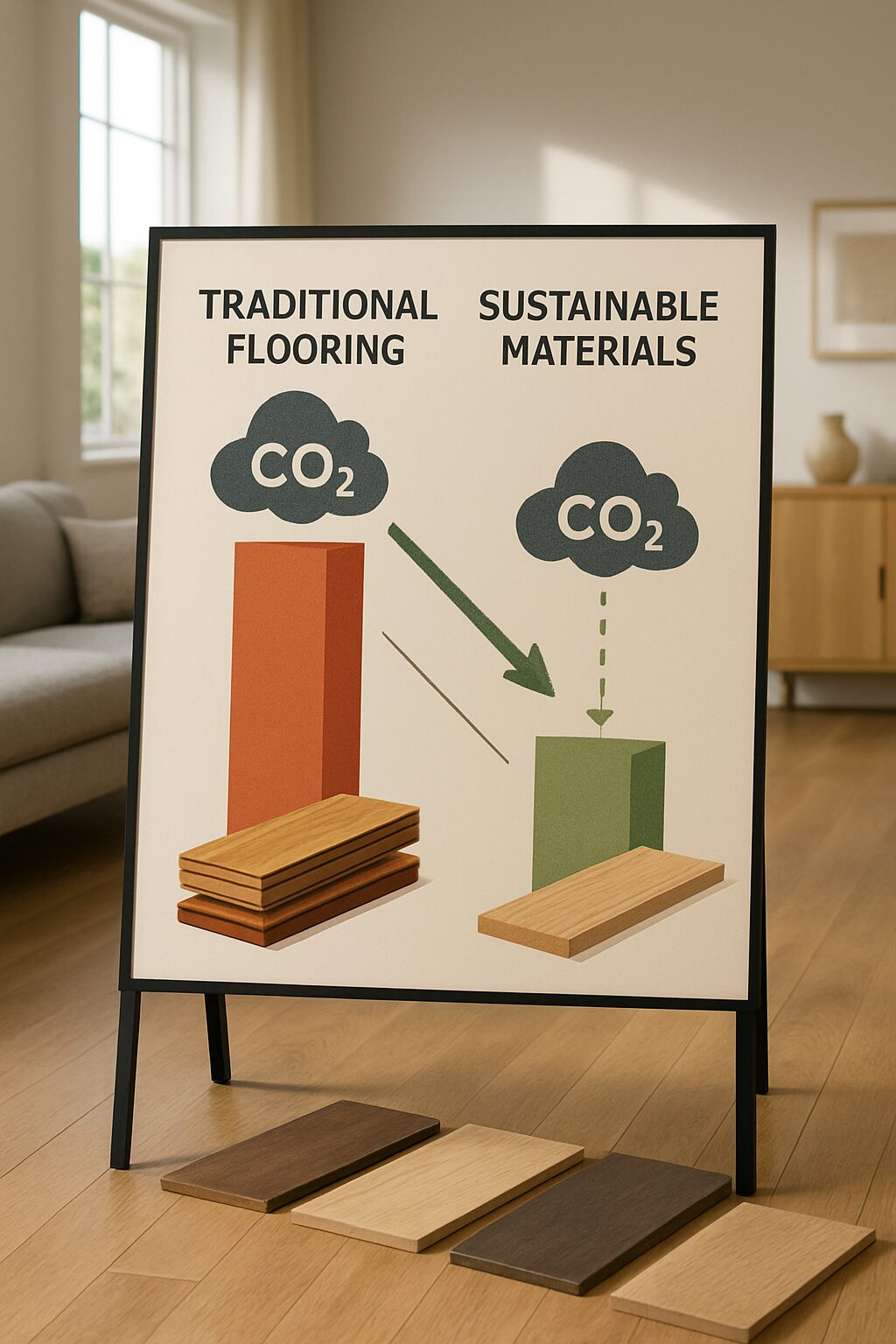Did you know that traditional flooring materials contribute to over 10% of landfill waste globally every year? If you’re searching for flooring options that match your values and style, it’s time to explore eco-friendly flooring solutions. This in-depth guide will help you make sustainable choices that benefit both your home and the planet—reducing your carbon footprint while transforming your living space into an inviting, modern haven. From bamboo flooring and cork flooring to recycled tiles and wool carpets, you’ll learn which flooring material fits your needs, how to identify authentic sustainable options, and how to maximize your investment in friendly flooring. Let’s change your floors—and the world—one plank at a time.
- Did you know that traditional flooring materials contribute to over 10% of landfill waste globally every year? This comprehensive guide showcases proven eco-friendly flooring solutions that not only reduce environmental impact but also add value and style to your space.
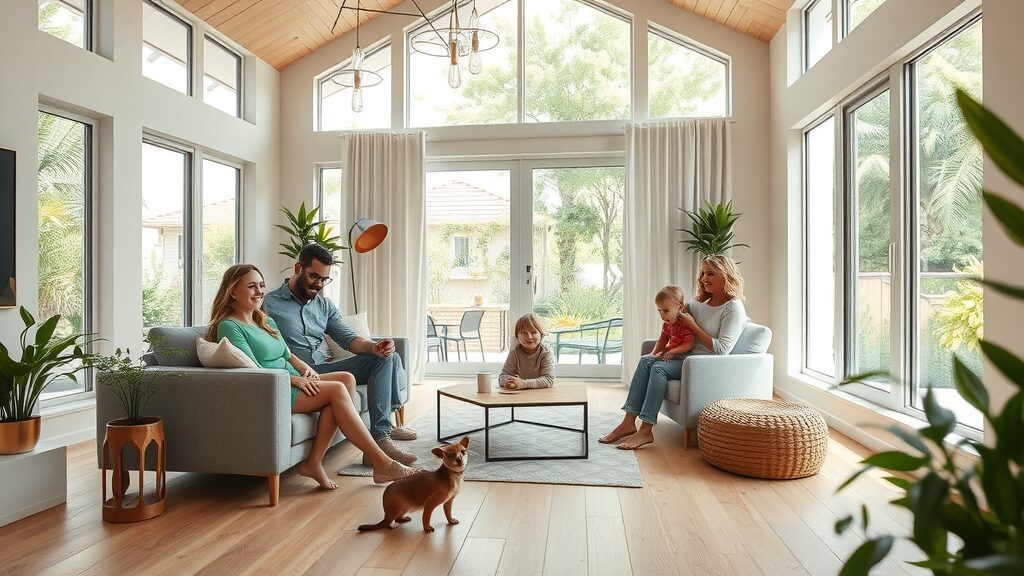
Eco-Friendly Flooring Solutions: Transform Your Home and the Planet
Eco-friendly flooring solutions are more than just a trend—they’re a powerful way to align your home with sustainability and health. Modern consumers seek out eco-friendly flooring options not only for their low environmental impact but also for their many practical benefits. These flooring solutions use materials like bamboo, cork, reclaimed wood, and recycled tiles, all chosen for their low toxicity, renewability, and lasting appeal.
When you opt for eco-friendly flooring, you’re not compromising style or quality. Instead, you’re investing in floors that are designed for durability, elegance, and long-term savings. Sustainable flooring solutions can enhance your home’s air quality, offer striking design possibilities, and provide exceptional comfort underfoot. Whether your priority is minimal environmental impact or a healthier home for your family, today’s friendly flooring options offer a wide range of advantages and choices to suit every style and budget.
Understanding Eco-Friendly Flooring Solutions: The Need for Sustainable Choices
Why Eco-Friendly Flooring Solutions Matter: Environmental, Health, and Economic Benefits
- Improved indoor air quality, sustainable resource use, long-lasting value, and reduced environmental footprint.
Choosing sustainable flooring isn’t just about aesthetics; it’s about impact. Traditional flooring can emit volatile organic compounds (VOCs), cause deforestation, and lead to waste that lasts decades in landfills. Eco-friendly flooring solutions, by contrast, are purposefully designed to minimize environmental impact from harvest to installation. Materials like bamboo and cork flooring grow quickly and regenerate, while reclaimed wood flooring repurposes existing resources, sparing forests and wildlife.
From a health standpoint, sustainable flooring often means fewer harmful chemicals and better indoor air quality—especially important in family spaces. Economic factors are also compelling: While some eco-friendly floors have a higher upfront cost, they often deliver long-term savings thanks to their durability and lower maintenance needs. By making eco-conscious choices now, homeowners can realize value that goes far beyond their flooring solution’s surface.
How to Identify Genuine Eco-Friendly Flooring Options
- Certifications (FSC, GreenGuard), renewable sources, low-VOC finishes, and responsible manufacturing practices.
Not every product claiming to be a sustainable flooring solution lives up to the hype. Look for independent certifications such as the Forest Stewardship Council (FSC) for wood flooring and GreenGuard for low emissions. Materials used should be rapidly renewable, recycled, or reclaimed, and manufacturers should be transparent about sourcing and production. Low-VOC adhesives and finishes are essential for healthy, friendly flooring.
Responsible brands will disclose where raw materials come from—such as bamboo from managed forests or cork harvested from the bark of the cork oak without harming the tree. Ask about the product’s life-cycle impacts, recycled content, and maintenance requirements. By demanding these details, you’ll ensure your new flooring option is truly eco-friendly and contributes to a healthier home and planet.

Comprehensive Overview of Sustainable Flooring and Friendly Flooring Solutions
Top Sustainable Flooring Materials: What Sets Them Apart?
- Explore bamboo flooring, cork floor, reclaimed wood flooring, linoleum, recycled tile, and eco-friendly carpeting.
There’s a wide range of sustainable flooring options available for modern homes. Bamboo flooring delivers the beauty of hardwood flooring but comes from a rapidly renewable grass rather than slow-growing trees. Cork flooring is harvested from the bark of cork oak trees—no trees are cut down, making this a highly renewable material. Reclaimed wood flooring upcycles existing timber, providing a historic look and a sustainable edge.
Linoleum is making a comeback as a biodegradable classic, made from linseed oil, wood flour, and jute. Recycled tiles, crafted from post-consumer glass or ceramics, turn waste into modern masterpieces. Wool carpeting offers comfort, hypoallergenic properties, and is made from natural fibers. Each friendly flooring solution offers a unique blend of style, durability, and environmental responsibility—helping you create a healthier home and a greener world.
Sustainable Flooring vs. Traditional Options: How Do They Compare?
| Comparing Eco-Friendly Flooring Solutions vs. Conventional Flooring Options | ||||
| Flooring Option | Durability | Cost | Environmental Impact | Aesthetics |
|---|---|---|---|---|
| Bamboo Flooring | High | Moderate | Very Low | Modern, Sleek |
| Cork Flooring | Moderate | Moderate | Very Low | Warm, Unique |
| Reclaimed Wood Flooring | Very High | Higher | Lowest | Rustic, Timeless |
| Traditional Hardwood Flooring | Very High | High | High | Classic, Variable |
| Carpet (Synthetic) | Moderate | Low | Very High | Soft, Variable |
| Vinyl/Plastic | High | Low | Very High | Varied |
As the table shows, eco-friendly flooring materials often outperform conventional flooring options in sustainability and health, while still offering competitive durability and a variety of design choices.
Bamboo Flooring: A Fast-Growing Eco-Friendly Flooring Solution
Advantages of Bamboo Flooring as a Friendly Flooring Option
- Rapid renewability, comparable hardness to hardwood flooring, and unique design appeal.
Bamboo flooring is celebrated for its rapid growth rate—making it a leading renewable material in the flooring industry. Harvested every 3-5 years, bamboo outpaces traditional wood, which can take decades to mature. When processed into flooring material, it becomes as hard as many hardwood flooring types and offers resistance to dents and scratches. The unique grain and color variations of bamboo add contemporary flair to friendly flooring solutions, satisfying design-conscious homeowners.
This sustainable flooring option is naturally pest-resistant, requires fewer pesticides, and thrives without chemical fertilizers. It provides a clean, modern look and works well in almost any room, making bamboo flooring a top pick for those seeking eco-friendly flooring solutions without sacrificing style or strength.
Installation and Maintenance Tips for Bamboo Flooring
Installing eco-friendly bamboo flooring can be done as a floating, nail-down, or glue-down floor, depending on your room’s needs. Always use low-VOC adhesives to maintain healthy indoor air quality during and after installation. Proper acclimation of bamboo planks to your home’s humidity will prevent warping.
Maintenance is straightforward: Sweep or vacuum regularly, use a damp mop for cleaning, and avoid excessive water. Place mats at entryways to reduce grit and prevent scratches. Rapid installation and easy upkeep add to bamboo’s reputation as a practical and attractive friendly flooring option for modern living.
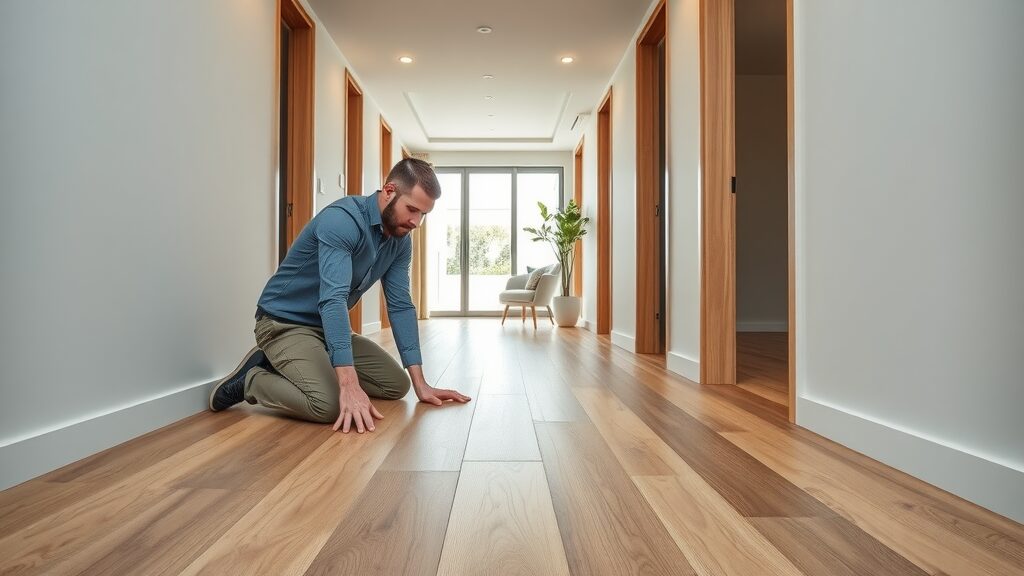
Cork Flooring: Unique Aesthetics with Stellar Sustainability Credentials
Benefits of Cork Floor in Eco-Friendly Flooring Solutions
- Naturally renewable, hypoallergenic, thermal insulation properties, and shock-absorbency.
Cork flooring comes from the bark of the cork oak tree, harvested every 9–12 years without harming the oak tree itself. This makes cork a truly renewable material, prized for its sustainability and comfort. The cellular structure of cork floor acts as a natural insulator, keeping your home warm in winter and cool in summer while absorbing shock for gentle support underfoot.
Friendly flooring made from cork is naturally hypoallergenic and resists mold, mildew, and pests, making it ideal for allergy-prone spaces. Besides its environmental and health benefits, cork flooring brings a soft, resilient feel and subtle beauty to rooms, bridging eco values with functional, stylish design.
Ideal Uses and Care Routines for Cork Flooring
Cork flooring works particularly well in bedrooms, kitchens, offices, and playrooms—anywhere you want softness underfoot and a touch of warmth. Protect cork with felt pads on furniture, clean spills promptly, and use PH-neutral cleaners. Reapply natural wax or polyurethane every few years to restore luster and enhance durability.
Installers should seal gaps during installation and acclimate the flooring to reduce expansion and contraction. By respecting cork’s need for gentle cleaning and minor maintenance, you’ll extend its life and preserve its unique friendly flooring qualities.
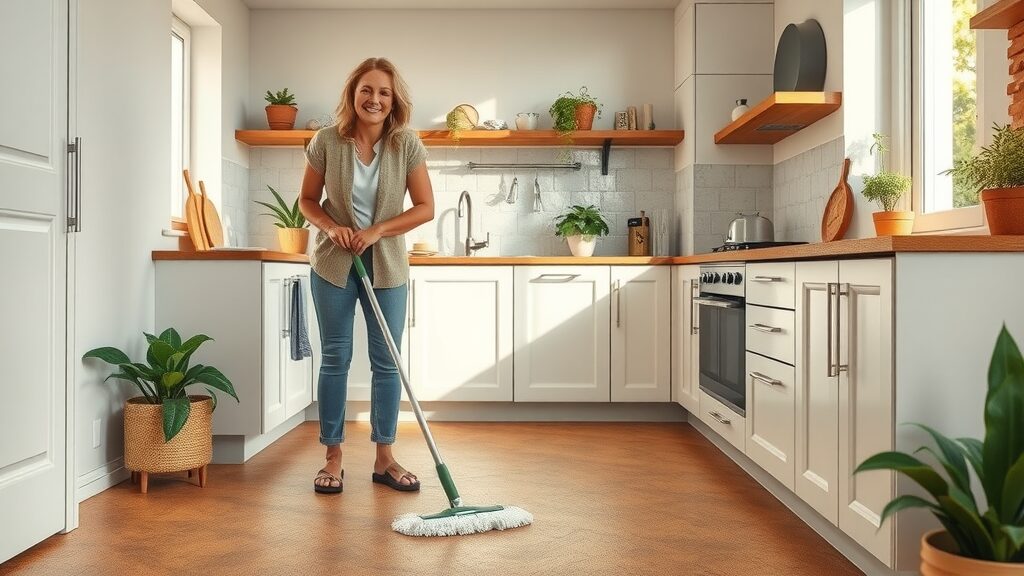
Reclaimed Wood Flooring: Timeless Beauty, Minimal Environmental Impact
Why Choose Reclaimed Wood Flooring as a Sustainable Flooring Solution?
- Upcycling existing timber, reducing deforestation, each plank tells a story.
Reclaimed wood flooring is the ultimate in eco-friendly flooring solutions for those drawn to authenticity and environmental responsibility. By upcycling wood from old barns, factories, and warehouses, this option reduces waste and preserves historic charm. With no new trees cut down, you’re helping combat deforestation and supporting the circular economy.
Every plank of reclaimed wood comes with a history—visible in its weathered textures and unique grain patterns. Reclaimed wood flooring stands out for its durability and can rival new hardwood flooring, offering unmatched visual richness. It’s a sustainable flooring solution that brings luxury, character, and environmental stewardship home.
Performance and Maintenance Best Practices for Wood Floor Options
Reclaimed wood flooring performs exceptionally well in high-traffic and modern spaces. To keep it looking its best, regularly dust or vacuum, use a damp mop, and address spills quickly to avoid stains. Periodic refinishing with natural oil or wax will revitalize worn areas and keep floors shining.
Use felt pads under furniture to prevent scratches and control humidity to minimize expansion or contraction. Reclaimed wood floors are hardy, but require attentive care—rewarding owners with a surface that gets better with age and aligns with your green living goals.
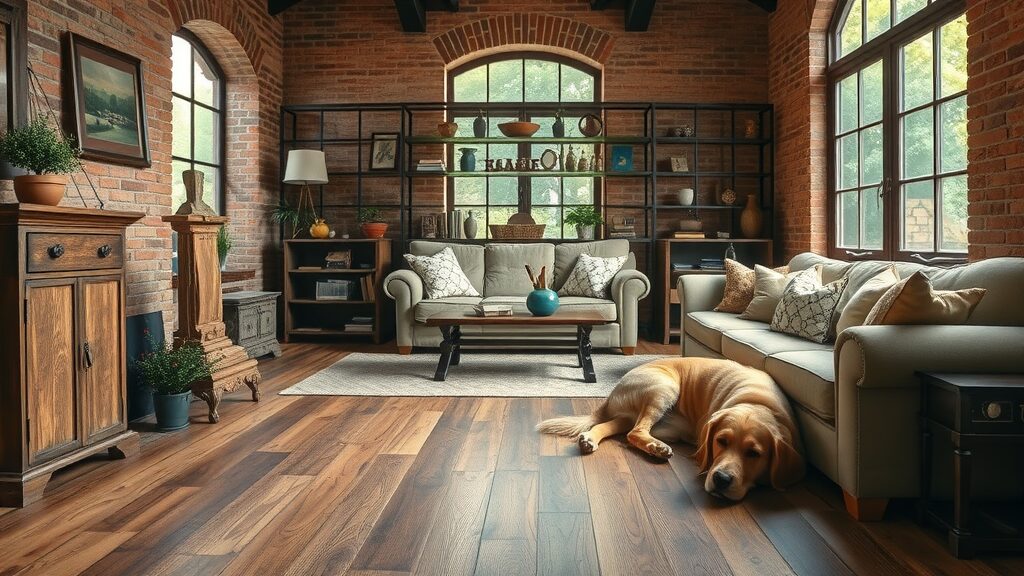
Other Flooring Solutions: Linoleum, Recycled Tiles, and Wool Carpeting
Linoleum: Classic Yet Sustainable Flooring Choice
- Made from linseed oil, wood flour, and jute backing—biodegradable and durable.
Linoleum is made from natural materials—primarily linseed oil , wood flour, and jute. Unlike vinyl, linoleum is free from synthetic chemicals and plasticizers and is entirely biodegradable. This sustainable flooring option is resilient, antibacterial, and lasts decades when properly maintained, making it a smart pick for those seeking a natural material underfoot.
Linoleum is available in a wide range of colors and patterns, offering versatility for kitchens, hallways, and living areas. Its tough surface resists stains and heavy foot traffic, all while contributing minimal environmental impact.
Recycled Content Tiles: Turning Waste into Friendly Flooring
- Glass and ceramic tile options made from post-consumer materials.
Recycled-content tiles represent another innovative eco-friendly flooring solution. Manufacturers create glass and ceramic tiles from post-consumer recycled materials, diverting significant waste from landfills and transforming it into stylish, durable surfaces. These tiles can be used throughout the home—kitchens, bathrooms, and entryways—and are available in an endless variety of designs.
Eco-friendly tiles are easy to maintain, stain-resistant, and don’t off-gas volatile organic compounds, making them ideal for improving indoor air quality and reducing environmental impact.
Natural Wool Carpet: Superior Indoor Air Quality and Comfort
Natural wool carpeting is made from rapidly renewable sheep’s wool, a non-toxic and highly biodegradable resource. Unlike synthetic carpets, wool is hypoallergenic, naturally resists mold and pests, and doesn’t release toxic chemicals into your home. Wool carpets are luxuriously soft underfoot, regulate temperature and humidity, and provide excellent sound insulation.
Maintenance is easy—vacuum regularly and blot spills promptly. When paired with a jute or natural rubber backing, wool carpeting is the ideal eco-friendly flooring solution for bedrooms, nurseries, and family rooms where comfort and safety are key.

How to Choose the Best Eco-Friendly Flooring Solution for Your Space
Prioritizing Your Flooring Option: Lifestyle, Budget, and Environmental Goals
- Assess traffic, moisture, maintenance level, and long-term value.
When selecting among eco-friendly flooring options, consider your space’s usage and environmental goals. High-traffic areas—like entryways or kitchens—benefit from durable options such as bamboo or recycled tiles. Moisture-prone rooms call for materials that resist water, like linoleum or sealed cork flooring. Think about maintenance preferences; some materials, such as reclaimed wood, need refinishing, while bamboo and wool may only require routine cleaning.
Finally, weigh up your budget with long-term value and environmental impact. Investing in a sustainable flooring solution isn’t just about upfront cost—it’s about lasting quality, reduced replacement cycles, and a home environment that nurtures your family and the earth.
Questions to Ask Suppliers About Eco-Friendly Flooring Options
Before purchasing, always ask your flooring supplier:
– Does the product have third-party certifications for sustainability (FSC, GreenGuard, etc.)?
– What is the content of recycled or renewable materials?
– Are finishes and adhesives free from harmful VOCs and other chemicals?
– Where are raw materials sourced and how are they processed?
– What is the expected lifespan and warranty coverage of the flooring material?
Clear communication ensures you’re investing in a truly eco-friendly flooring solution.
Installation Strategies for Eco-Friendly Flooring Solutions
Professional vs. DIY: What Works Best for Eco-Friendly Floors?
Many eco-friendly flooring solutions can be installed by skilled DIYers, especially click-lock bamboo or cork panels. DIY approaches save money and let you control the adhesives and sealants used. However, installation of reclaimed wood flooring and recycled tiles often require specialized skills for proper fitting, sealing, and finishing. Professional installers bring expertise in handling sustainable and fragile materials and will help prevent waste or mistakes.
Evaluate the complexity of your chosen flooring option, your skill level, and the room’s use before deciding—remember, proper installation ensures both performance and sustainability.
Green Installation Tips: Low-VOC Adhesives, Underlays, and Preparation
Make your new floor as eco-friendly as possible with smart installation strategies. Always use low-VOC adhesives and sealants to reduce indoor air pollution. Choose underlays made from natural fibers like wool, jute, or recycled felt to add comfort and insulation without synthetic chemicals. Prep subfloors thoroughly to ensure maximum lifespan and performance from your sustainable flooring.
Responsible disposal of demolition debris is also a must—donate or recycle old flooring material if possible. By taking a green approach to installation, you complete the circle of sustainability, ensuring every step aligns with your eco-friendly values.

Long-Term Care Steps to Maximize Friendly Flooring Lifespan
Routine Maintenance for Wood Flooring, Bamboo Flooring, and Cork Flooring
- Best cleaning agents, moisture management, and scratch prevention.
Regular maintenance is the best way to extend the life of your eco-friendly wood flooring, bamboo, or cork floor. Use a soft-bristled broom, microfiber mop, or vacuum with hard floor settings. Clean with PH-neutral, non-abrasive cleaners—avoid soaking surfaces or using steam, which can damage these natural materials. Manage indoor humidity with dehumidifiers or humidifiers as needed, particularly for wood floor options.
Protect floors by using mats at entries and felt pads under furniture legs. For cork flooring, reseal every few years with a natural wax or water-based polyurethane to prevent moisture absorption and maintain resilience. These routines help maintain the beauty, comfort, and sustainability credentials of your friendly flooring solution over time.
Repair and Refinishing Techniques for Sustainable Flooring
Sustainable flooring doesn’t mean high maintenance—but occasional repairs or refinishing may be needed. For minor scratches or dents, use repair kits recommended by the manufacturer. For deeper damage, sand and reapply natural oil, wax, or low-VOC finishes. Reclaimed wood flooring and bamboo can often be refinished multiple times, extending their lifespan for decades and maintaining their eco-friendly status.
Always consult the manufacturer’s guidelines and use products compatible with the flooring material. Proper care preserves both the appearance and environmental benefits of your sustainable flooring investment.
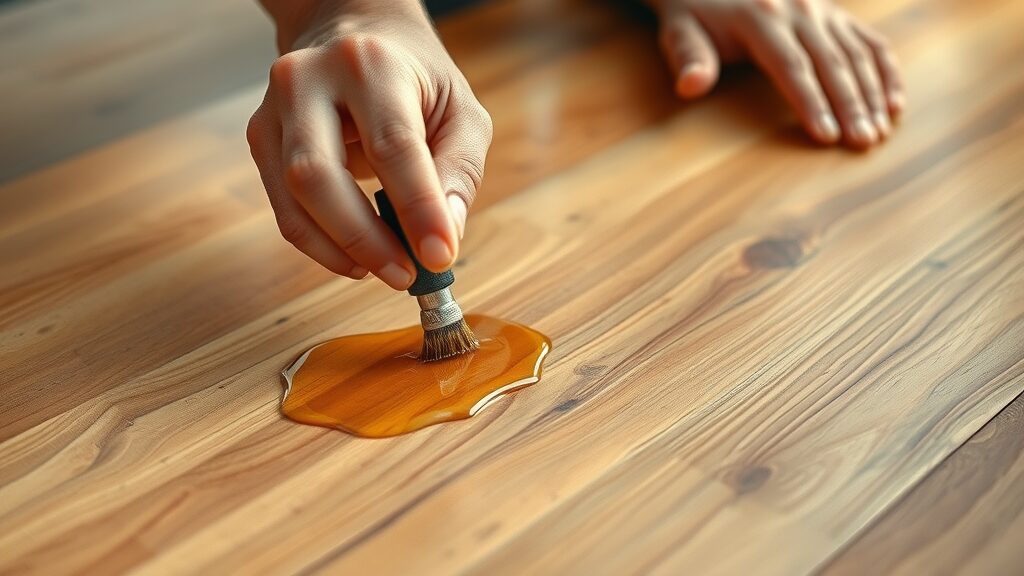
What is the most environmentally friendly flooring option?
Answer: The most environmentally friendly flooring option is typically reclaimed wood flooring, as it reuses existing materials, reduces deforestation, and has a timeless aesthetic.
What is the most environmentally friendly flooring?
Answer: Bamboo flooring and cork floor are both extremely environmentally friendly, sourcing from rapidly renewable materials and requiring minimal resources for production.
What kind of flooring is most environmentally friendly?
Answer: Flooring made from natural, renewable or recycled content, such as cork flooring, bamboo flooring, and recycled tile, are considered the most eco-friendly flooring options available.
What is the most environmentally friendly floor covering?
Answer: Eco-friendly flooring coverings include natural wool carpets, cork floor, and linoleum—all free from toxic chemicals and sourced responsibly.
Spotlight on Trends: Innovative Friendly Flooring Products for Modern Homes
Emerging Eco-Friendly Flooring Options and Materials
- Advances in plant-based composites, sustainable vinyl alternatives, and bioplastics.
The flooring industry continues to innovate with cutting-edge eco-friendly options. New plant-based composites blend renewable fibers like hemp and flax to create high-performance panels. Sustainable vinyl alternatives use safer plasticizers and recycled content, while bioplastic-based tiles and planks minimize dependence on fossil fuels.
Many manufacturers now offer fully circular products—floors that can be fully recycled or composted at the end of their lifespan. As demand grows, expect an even wider range of sustainable flooring solutions with improved aesthetics and reduced environmental impact.
Buyer’s Checklist: Evaluating Sustainable Flooring Solutions
- Checklist with criteria such as certifications, life cycle analysis, durability, and warranty coverage.
When evaluating eco-friendly flooring solutions, use this checklist:
- Certified by credible organizations (FSC, GreenGuard, Cradle to Cradle)
- Made from renewable, recycled, or upcycled materials
- Low-VOC adhesives, finishes, and underlays
- Transparent information about sourcing and manufacturing
- Lifecycle sustainability and recyclability
- Durability and warranty coverage
Notable Quotes from Sustainability Experts and Designers
“Choosing eco-friendly flooring solutions is an investment in the future of both your home and the planet. Sustainable flooring doesn’t mean sacrificing style for environmental consciousness.” — Jane Doe, Eco-Design Specialist
Frequently Asked Questions about Eco-Friendly Flooring Solutions
- Are eco-friendly flooring options more expensive than traditional floors?
While initial costs may be higher, long-term durability and reduced maintenance often make eco-friendly options more affordable over time. Tax credits or incentives may lower up-front expenses too. - How do I maintain sustainable flooring to extend its life?
Regular cleaning with suitable products, managing humidity, and periodic refinishing will prolong the life of eco-friendly floors like bamboo, hardwood, and cork flooring. - Can eco-friendly flooring solutions help improve resale value?
Yes. Homebuyers increasingly seek eco-friendly features. Well-maintained sustainable flooring can raise a home’s market appeal and value. - What warranties are available on sustainable flooring products?
Many manufacturers offer warranties ranging from 10 years to lifetime for their sustainable flooring options. Always ask for details before purchase. - How do I verify that a product is genuinely eco-friendly?
Check for trusted certifications, ask about material sourcing, and verify that adhesives and finishes are low-VOC or non-toxic. Reputable brands will provide full transparency.
Key Takeaways for Eco-Friendly Flooring Solutions
- Eco-friendly flooring solutions are accessible, diverse, and highly effective at reducing environmental impact.
- Sustainable flooring materials offer both durability and design versatility.
- Careful selection and proper maintenance ensure long-term satisfaction with your eco-friendly flooring investment.
Take Action: Upgrade Your Space with Eco-Friendly Flooring Solutions
- Get quality flooring and 5-star service—call HomeTown Floors today at (636) 244-4951 or book online at www.hometownfloorsonline.com!
Ready to revolutionize your space and the planet? Choose sustainable flooring for a healthier, more beautiful home—start today!

